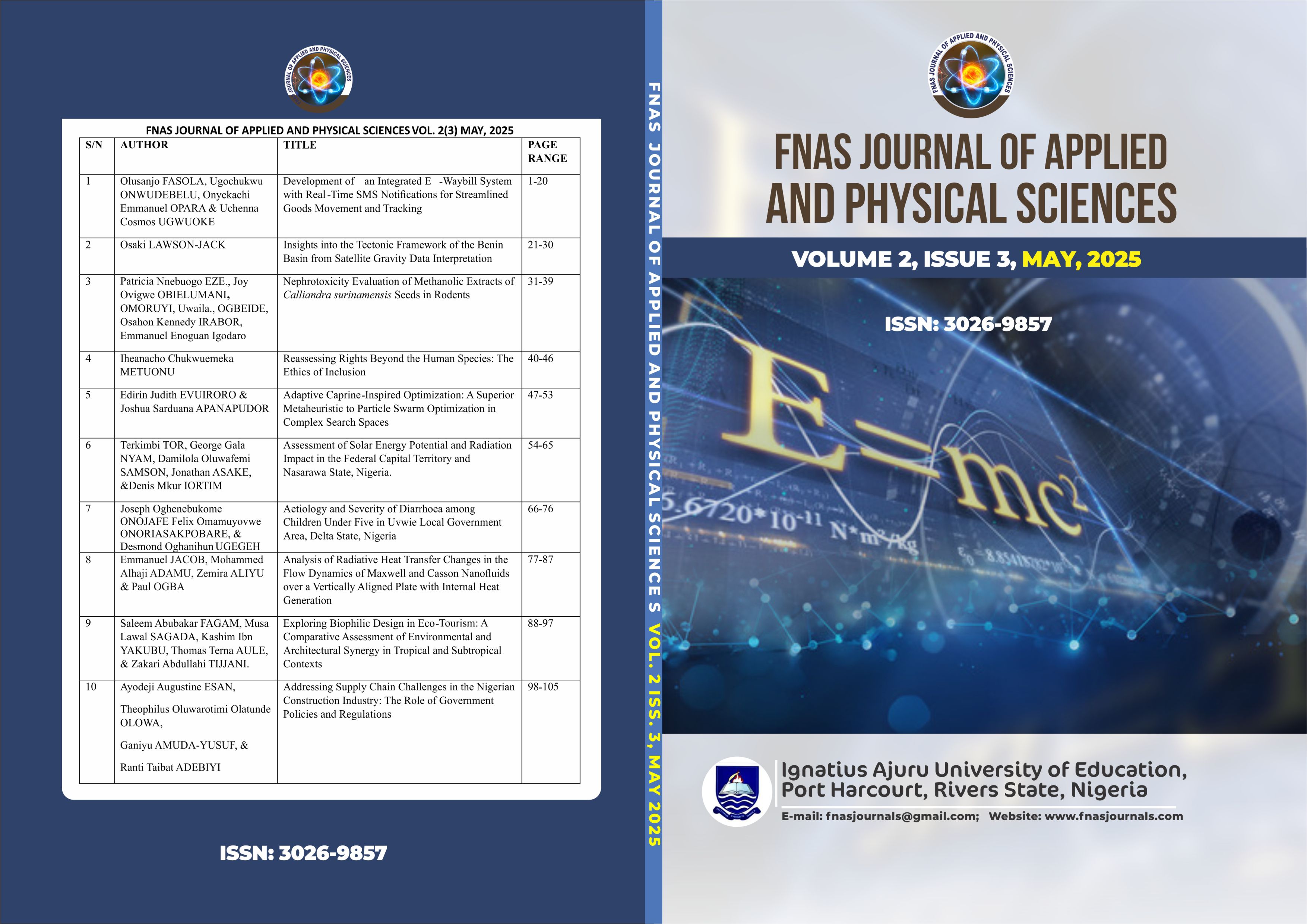Assessment of Solar Energy Potential and Radiation Impact in the Federal Capital Territory and Nasarawa State, Nigeria.
DOI:
https://doi.org/10.63561/japs.v2i3.814Keywords:
Solar Energy Potential, Radiation Impact, Clearness Index, FCT, NasarawaAbstract
This study assesses the solar energy potential and radiation impact in the Federal Capital Territory (FCT) and Nasarawa State (NS), Nigeria, over ten years. Two main analyses were carried out: electricity generation potential and descriptive statistical analysis. It was observed that the solar radiation for FCT ranges from 11.4 MJm⁻² day⁻¹ to 22.0 MJm⁻² day⁻¹, with an average value of 17.6 MJm⁻² day⁻¹, and a total annual solar radiation of 211.7 MJm⁻² day⁻¹. In contrast, NS ranges from 11.8 MJm⁻² day⁻¹ to 22.2 MJm⁻² day⁻¹, with an average value of 17.5 MJm⁻² day⁻¹, and a total annual solar radiation of 209.6 MJm⁻² day⁻¹. During the off-rainy season, both regions demonstrated high reliability for solar power generation, with FCT showing a reliability of 0.62 and NS a reliability of 0.56. The performance of photovoltaic systems was also evaluated using a 550 W PV panel with FCT having a value of 6.206 x 107 MWh annually, while NS can produce 2.27 x 108 MWh. The observed clearness index (K_t) ranges between 0.414 – 0.665 and 0.432 – 0.662 for both FCT and NS. Moreover, the skewness values for FCT and NS are -0.379 and -0.220, respectively, suggesting that the distribution’s tail is slightly shifted towards the left for both FCT and NS. The kurtosis results for both regions exhibit values of approximately FCT (1.322) and NS (1.168), indicating that the distributions are platykurtic. These results suggest that both regions have substantial potential for solar energy generation.
References
Adaramola, M. S., & Paul, S. S. (2017). Economic analysis and potential feed-in tariff of grid-connected PV systems in Nigeria. Environmental Progress & Sustainable Energy, 36(1), 305–314. https://doi.org/10.1002/ep.12482 DOI: https://doi.org/10.1002/ep.12502
Adavuruku, B. M., Aghaegbunam, E. J., Chidozie, I. K., & Stephen, M. A. (2022). Geospatial analysis of solar energy potentials in Niger State, Nigeria. American Journal of Modern Physics, 11(6), 85–94. https://doi.org/10.11648/j.ajmp.20221106.12 DOI: https://doi.org/10.11648/j.ajmp.20221106.12
Ajayi, O. O., Olawale, A. S., & Nwankwo, U. C. (2021). Challenges and prospects of solar energy utilization in Nigeria: A policy perspective. Journal of Sustainable Energy Research, 16(2), 115–132.
Akinyele, D. O., & Odewumi, S. O. (2021). Energy development in Nigeria: The role of solar power. Renewable Energy Technology, 28(1), 45–58.
Alami, A., & Khaled, M. (2021). Solar energy development in the MENA region: Challenges and opportunities. Renewable Energy Reports, 18(2), 156–172.
Brivana Solar. (2025). Nigeria’s solar energy policy evolution. https://brivana.com.ng
Chanchangi, Y. N., Ghosh, A., Sundararajan, A., & Mallick, T. K. (2023). Assessment of solar radiation as a power generation source in Nigeria. Journal of Renewable and Sustainable Energy, 15(1), 013102. https://doi.org/10.1063/5.0115090 DOI: https://doi.org/10.1063/5.0115090
DeCarlo, L. T. (2019). On the meaning and use of kurtosis and skewness: A historical review and look to the future. International Journal of Statistics and Probability, 8(2), 15–30. https://doi.org/10.5539/ijsp.v8n2p15
Eke, J. (2020). Solar energy and its role in Nigeria’s energy crisis. Renewable Energy Journal, 32(3), 174–186.
International Energy Agency. (2020). Renewable energy market analysis 2020. https://www.iea.org/reports/renewable-energy-market-analysis
International Energy Agency. (2022). World energy outlook 2022. https://www.iea.org/reports/world-energy-outlook-2022
International Journal of Energy. (2020). Challenges in scaling solar energy in Nigeria. IOP Conference Series: Earth and Environmental Science, 83(1), 012015. https://doi.org/10.1088/1755-1315/83/1/012015 DOI: https://doi.org/10.1088/1755-1315/83/1/012015
Irekeola, B. J., Bori, I., Adedipe, O., & Babawuya, A. (2020). Analysis of solar energy potentials in Katsina and Sokoto States, Nigeria. In Proceedings of the 33rd Conference of the Nigerian Society of Engineers (NSE) (pp. 186–192). http://repository.futminna.edu.ng:8080/jspui/handle/123456789/1816
Li, X., Yang, Z., & Xu, W. (2021). China’s solar energy expansion: Technological advancements and policy impacts. Journal of Renewable Energy, 14(3), 210–228.
Nigerian Electricity Regulatory Commission. (2025). Regulatory reforms for solar energy in Nigeria. https://nerc.gov.ng/index.php/library/documents
Okonkwo, G. N., Adegbite, S. O., & Yusuf, M. T. (2020). Solar radiation assessment in selected Nigerian locations: A case for sustainable energy development. Renewable Energy Journal, 49(1), 290–305.
Olatomiwa, L., Mekhilef, S., & Sanusi, K. O. (2023). Renewable energy integration for sustainable electricity supply in Nigeria: A review. Renewable and Sustainable Energy Reviews, 180, 113980. https://doi.org/10.1016/j.rser.2023.113980 DOI: https://doi.org/10.1016/j.rser.2023.113980
Patriot NG. (2025). Solar power adoption in Nigeria: A lifeline for energy-deficient communities. https://patriot.ng
Primeteknologies. (2025). Solar energy revolution in Nigerian industries. https://primeteknologies.com
Reuters. (2024, August 12). Nigeria-China economic pact boosts solar energy cooperation. Reuters News. https://www.reuters.com
Shaaban, M., & Petinrin, J. O. (2014). Renewable energy potentials in Nigeria: Meeting rural energy needs. Renewable and Sustainable Energy Reviews, 29, 72–84. https://doi.org/10.1016/j.rser.2013.08.078 DOI: https://doi.org/10.1016/j.rser.2013.08.078
Soneye, O. O. (2020). Evaluation of clearness index and cloudiness index using measured global solar radiation data: A case study for a tropical climatic region of Nigeria. Atmósfera, 34(1), 25–39. https://doi.org/10.20937/ATM.52796 DOI: https://doi.org/10.20937/ATM.52796
Sun King. (2023). Solar energy adoption trends in Nigeria. https://www.sunking.com
U.S. Department of Energy. (2022). Solar energy growth in the United States: Current status and future projections. Office of Energy Efficiency & Renewable Energy. https://www.energy.gov/eere
Udeh, C., Eze, S., & Umeora, O. (2023). An evaluation of solar radiation and energy potential in northern Nigeria. Energy Reports, 9, 123–135. https://doi.org/10.1016/j.egyr.2023.01.012 DOI: https://doi.org/10.1016/j.egyr.2023.01.012
Wang, L., Zhao, H., & Chen, Q. (2020). Comparative analysis of solar power policies in China, Australia, and the USA. Journal of Energy Policy, 52(4), 321–339. https://doi.org/10.1016/j.enpol.2020.04.005
World Bank. (2021a). Nigeria energy access scale-up: A comprehensive overview. https://www.worldbank.org/en/country/nigeria
World Bank. (2021b). Nigeria Electrification Project. https://www.worldbank.org/en/news/feature/2021/03/04/nigeria-electrification-project









